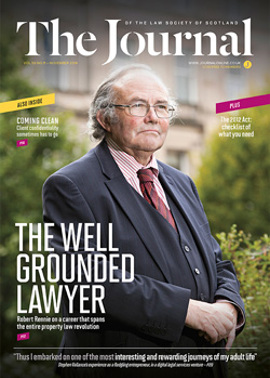LBTT: the rules and rates emerge

In the final few months before the switchover from SDLT to LBTT on 1 April 2015, Revenue Scotland is making good progress in its preparation to administer the first taxes set by a Scottish Parliament in more than 300 years.
Key to this progress is recruiting people with the right skills and experience, and I am pleased to announce that Stephen Crilly, currently in the HMRC Division of the Office of the Advocate General, has been appointed as Solicitor to Revenue Scotland.
Legislation
The Revenue Scotland and Tax Powers Act 2014 (RSTPA 2014) was granted Royal Assent on 24 September. This completes the trilogy of statutes which allow Revenue Scotland to be constituted as a non-ministerial department to collect the two devolved taxes, LBTT and SLfT (Scottish Landfill Tax).
The Scottish Government is currently consulting on the secondary legislation provided for in the RSTPA 2014. There are two consultation papers, both available on the Scottish Government website, one dealing with tribunal rules and the other covering the rest of the proposed subordinate legislation.
Submissions to both consultations and details on how to respond can be found at www.scotland.gov.uk/Publications
Proposed LBTT rates and bands
In October, the Cabinet Secretary for Finance, Employment & Sustainable Growth, John Swinney, announced the proposed rates and bands for LBTT as part of the draft Budget statement for 2015-16.
LBTT is a progressive tax and ministers have stated that the intention is that tax levied is proportionate to the taxpayerís ability to pay. This means there is a sliding scale where the tax rises. This contrasts with the slab structure of SDLT, under which the higher tax rate is payable on the whole purchase price when a threshold is crossed.
Tax calculators are available on the LBTT page of the Scottish Government website at www.scotland.gov.uk/Topics/Government/Finance/scottishapproach
These will be moved to the Revenue Scotland website when it goes live.
Guidance
Guidance is being drafted to provide taxpayers and their agents with the information they will need to complete and submit accurate tax returns. The Law Society of Scotland and other key stakeholders will be invited to comment on the draft guidance before publication on the Revenue Scotland website early in 2015.
Charter of Standards and Values
Under RSPTA 2014, we are required to publish a Charter of Standards and Values. A discussion paper on the contents of the Charter has been circulated to key stakeholders, including the Law Society of Scotland Tax Committee. Responses to this paper will inform a draft Charter and our intention is to issue this as part of a formal public consultation in early 2015.
| PROPOSED LBTT RATES AND BANDS | |||
| RESIDENTIAL TRANSACTIONS | NON-RESIDENTIAL OR MIXED PROPERTY | ||
| RATE | RATE | ||
| UP TO 135,000 | nil | UP TO 150,000 | nil |
| 135,000 TO 250,000 | 2% | 150,000 TO 350,000 | 3% |
| 250,000 TO 1,000,000 | 10% | OVER 350,000 | 4.5% |
| OVER 1,000,000 | 12% | ||
LBTT residential rates – an example
On a house purchase of £300,000, LBTT is calculated as follows: 0% on the first £135,000 2% between £135,000 and £250,000 = £2,300 10% between £250,000 and £300,000 = £5,000 LBTT due = £7,300
In this issue
- Age before duty
- Title to tissue
- Standing the test of time?
- Adjudication: a risk of abuse?
- Courts in all but name
- When is a person a “relevant person”?
- Reading for pleasure
- Opinion: John Scott QC
- Book reviews
- Profile
- President's column
- People on the move
- The designated day is here
- A tale of two systems
- LBTT: the rules and rates emerge
- The price of probity
- Play to your strengths
- Into the unknown
- A changing landscape
- Get the basics right
- Holiday pay: give us a break
- Money into thin air?
- Pathways to justice
- Flesh on the bones
- Scottish Solicitors Discipline Tribunal
- Streams of thought
- Over the finishing line
- Over the finishing line (full version)
- Law reform roundup
- The path less travelled
- The right kind of risk
- Frauds and scams – increasing awareness
- Ask Ash
- The process engineer's tale
- To disclose or not to disclose?






